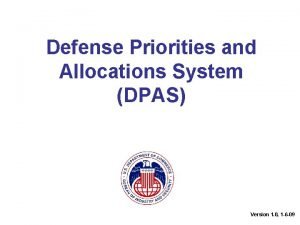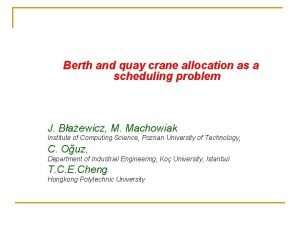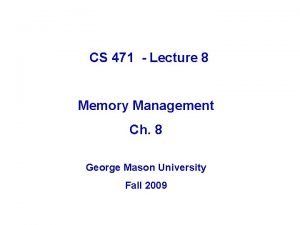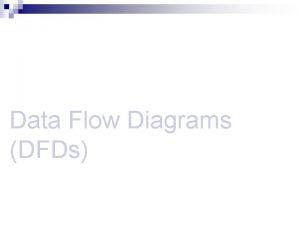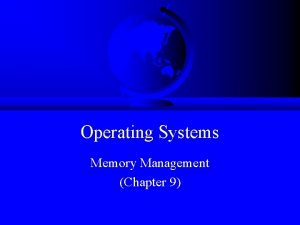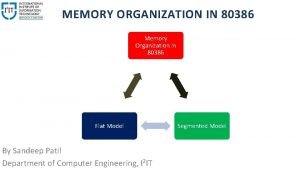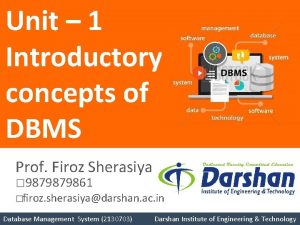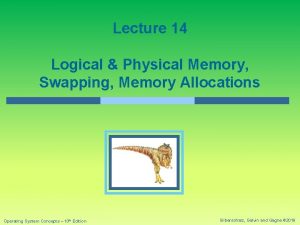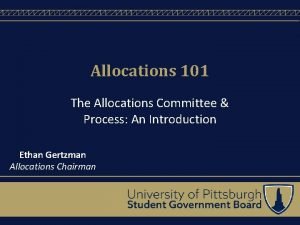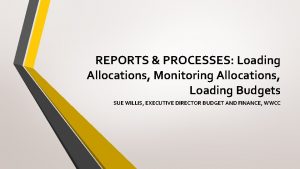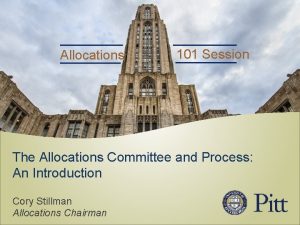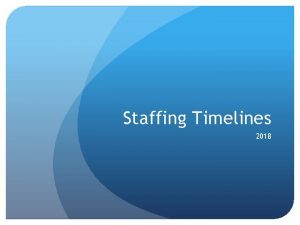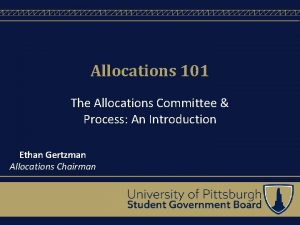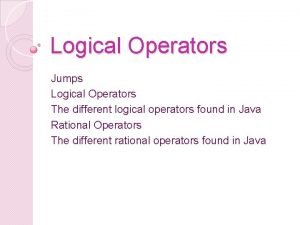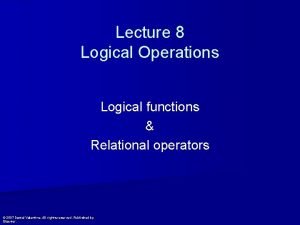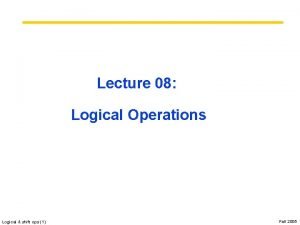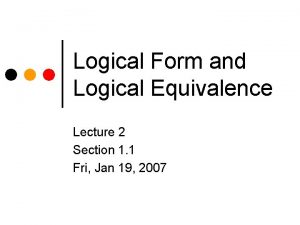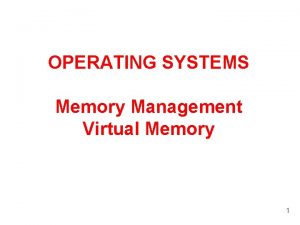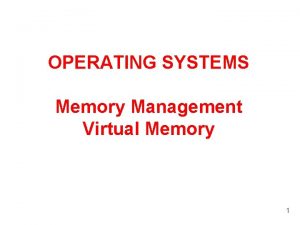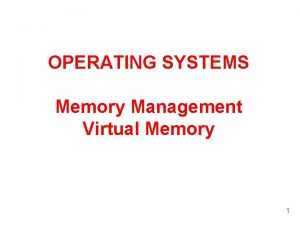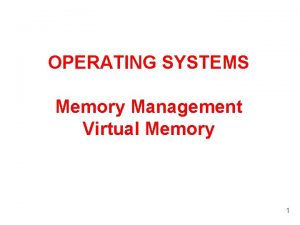Lecture 15 Logical Physical Memory Memory Allocations Operating







































- Slides: 39

Lecture 15 Logical & Physical Memory, Memory Allocations Operating System Concepts – 10 th Edition Silberschatz, Galvin and Gagne © 2018

Outline 1. Background • • Basics of Memory Organization Address Binding Logical & Physical Memory Dynamic loading and linking 2. Memory Allocation • Contiguous Allocation • Allocation methods: o First-Fit (FF) o Best-Fit (BF) o Worst-Fit (WF) • Fragmentations Operating System Concepts – 10 th Edition 2. 2 Silberschatz, Galvin and Gagne © 2018

Outline KEYWORDS: Base register, Limit register, physical address, logical address, Binding, Compile time, Load time, Execution time, MMU, Swapping, Backing store, FF, BF, WF, Internal & External Fragmentation. § HOMEWORK: 1) Reading : Chapter 9, especially the summary. 2) Make sure to understand be able to explain every keyword from the list here and the ones which are printed bold in the text book. 3) Important Questions: 4 What is the advantage of dynamic loading? 4 Explain the difference between logical and physical addresses. 4 Explain the difference between internal and external fragmentation. 4 List the common allocation methods. Which is the poorest? What was the rationale for even considering it? 4 Given memory partitions of 100 K, 500 K, 200 K, 300 K, and 600 K (in that order), how would each of the First-fit, Best-fit, and Worst-fit algorithms place the processes of 212 K, 417 K, 112 K, and 426 K (in that order) ? Which algorithm makes the most efficient use of memory? Operating System Concepts – 10 th Edition 2. 3 Silberschatz, Galvin and Gagne © 2018

Outline 1. Background • • Basics of Memory Organization Address binding Logical & Physical Memory Dynamic loading and linking 2. Memory Allocation • Contiguous Allocation • Allocation methods: o First-Fit (FF) o Best-Fit (BF) o Worst-Fit (WF) • Fragmentations Operating System Concepts – 10 th Edition 2. 4 Silberschatz, Galvin and Gagne © 2018

Background § Program must be brought (from disk) into memory and placed within a process for it to be run § Main memory and registers are only storage CPU can access directly § Memory unit only sees a stream of: • addresses + read requests, or • address + data and write requests § Register access is done in one CPU clock (or less) § Main memory can take many cycles, causing a stall § Cache sits between main memory and CPU registers § Protection of memory required to ensure correct operation Operating System Concepts – 10 th Edition 2. 5 Silberschatz, Galvin and Gagne © 2018

Background Operating System Concepts – 10 th Edition 2. 6 Silberschatz, Galvin and Gagne © 2018

Protection § Need to censure that a process can access only access those addresses in it address space. § We can provide this protection by using a pair of base and limit registers define the logical address space of a process Operating System Concepts – 10 th Edition 2. 7 Silberschatz, Galvin and Gagne © 2018

Hardware Address Protection § CPU must check every memory access generated in user mode to be sure it is between base and limit for that user § the instructions to loading the base and limit registers are privileged Operating System Concepts – 10 th Edition 2. 8 Silberschatz, Galvin and Gagne © 2018

Outline 1. Background • • Basics of Memory Organization Address Binding Logical & Physical Memory Dynamic loading and linking 2. Memory Allocation • Contiguous Allocation • Allocation methods: o First-Fit (FF) o Best-Fit (BF) o Worst-Fit (WF) • Fragmentations Operating System Concepts – 10 th Edition 2. 9 Silberschatz, Galvin and Gagne © 2018

Address Binding Operating System Concepts – 10 th Edition 2. 10 Silberschatz, Galvin and Gagne © 2018

Address Binding § Programs on disk, ready to be brought into memory to execute form an input queue • Without support, must be loaded into address 0000 § Inconvenient to have first user process physical address always at 0000 • How can it not be? § Addresses represented in different ways at different stages of a program’s life • Source code addresses usually symbolic • Compiled code addresses bind to relocatable addresses 4 i. e. , “ 14 bytes from beginning of this module” • Linker or loader will bind relocatable addresses to absolute addresses 4 i. e. , 74014 • Each binding maps one address space to another Operating System Concepts – 10 th Edition 2. 11 Silberschatz, Galvin and Gagne © 2018

Binding of Instructions and Data to Memory § Address binding of instructions and data to memory addresses can happen at three different stages • Compile time: If memory location known a priori, absolute code can be generated; must recompile code if starting location changes • Load time: Must generate relocatable code if memory location is not known at compile time • Execution time: Binding delayed until run time if the process can be moved during its execution from one memory segment to another 4 Need hardware support for address maps (e. g. , base and limit registers) Operating System Concepts – 10 th Edition 2. 12 Silberschatz, Galvin and Gagne © 2018

Multistep Processing of a User Program Operating System Concepts – 10 th Edition 2. 13 Silberschatz, Galvin and Gagne © 2018

Address Binding Operating System Concepts – 10 th Edition 2. 14 Silberschatz, Galvin and Gagne © 2018

Outline 1. Background • • Basics of Memory Organization Address binding Logical & Physical Memory Dynamic loading and linking 2. Memory Allocation • Contiguous Allocation • Allocation methods: o First-Fit (FF) o Best-Fit (BF) o Worst-Fit (WF) • Fragmentations Operating System Concepts – 10 th Edition 2. 15 Silberschatz, Galvin and Gagne © 2018

Logical vs. Physical Address Space § The concept of a logical address space that is bound to a separate physical address space is central to proper memory management • Logical address – generated by the CPU; also referred to as virtual address • Physical address – address seen by the memory unit § Logical and physical addresses are the same in compile-time and loadtime address-binding schemes; logical (virtual) and physical addresses differ in execution-time address-binding scheme § Logical address space is the set of all logical addresses generated by a program § Physical address space is the set of all physical addresses generated by a program Operating System Concepts – 10 th Edition 2. 16 Silberschatz, Galvin and Gagne © 2018

Background Operating System Concepts – 10 th Edition 2. 17 Silberschatz, Galvin and Gagne © 2018

Background Operating System Concepts – 10 th Edition 2. 18 Silberschatz, Galvin and Gagne © 2018

Memory-Management Unit (MMU) § Hardware device that at run time maps virtual to physical address § Many methods possible, covered in the rest of this chapter Operating System Concepts – 10 th Edition 2. 19 Silberschatz, Galvin and Gagne © 2018

Memory-Management Unit (Cont. ) § Consider simple scheme. which is a generalization of the baseregister scheme. § The base register now called relocation register § The value in the relocation register is added to every address generated by a user process at the time it is sent to memory § The user program deals with logical addresses; it never sees the real physical addresses • Execution-time binding occurs when reference is made to location in memory • Logical address bound to physical addresses Operating System Concepts – 10 th Edition 2. 20 Silberschatz, Galvin and Gagne © 2018

Memory-Management Unit (Cont. ) § Consider simple scheme. which is a generalization of the baseregister scheme. § The base register now called relocation register § The value in the relocation register is added to every address generated by a user process at the time it is sent to memory Operating System Concepts – 10 th Edition 2. 21 Silberschatz, Galvin and Gagne © 2018

Outline 1. Background • • Basics of Memory Organization Address Binding Logical & Physical Memory Dynamic Loading and Linking 2. Memory Allocation • Contiguous Allocation • Allocation methods: o First-Fit (FF) o Best-Fit (BF) o Worst-Fit (WF) • Fragmentations Operating System Concepts – 10 th Edition 2. 22 Silberschatz, Galvin and Gagne © 2018

Dynamic Loading § § § The entire program does need to be in memory to execute § No special support from the operating system is required Routine is not loaded until it is called Better memory-space utilization; unused routine is never loaded All routines kept on disk in relocatable load format Useful when large amounts of code are needed to handle infrequently occurring cases • • Implemented through program design OS can help by providing libraries to implement dynamic loading Operating System Concepts – 10 th Edition 2. 23 Silberschatz, Galvin and Gagne © 2018

Dynamic Linking § Static linking – system libraries and program code combined by the loader into the binary program image § Dynamic linking –linking postponed until execution time § Small piece of code, stub, used to locate the appropriate memoryresident library routine § Stub replaces itself with the address of the routine, and executes the routine § Operating system checks if routine is in processes’ memory address • If not in address space, add to address space § Dynamic linking is particularly useful for libraries § System also known as shared libraries § Consider applicability to patching system libraries • Versioning may be needed Operating System Concepts – 10 th Edition 2. 24 Silberschatz, Galvin and Gagne © 2018

Outline 1. Background • • Basics of Memory Organization Address binding Logical & Physical addresses Dynamic loading and linking 2. Memory Allocation • Contiguous Allocation • Allocation methods: o First-Fit (FF) o Best-Fit (BF) o Worst-Fit (WF) • Fragmentations Operating System Concepts – 10 th Edition 2. 25 Silberschatz, Galvin and Gagne © 2018

Contiguous Allocation § § Main memory must support both OS and user processes Limited resource, must allocate efficiently Contiguous allocation is one early method Main memory usually into two partitions: • Resident operating system, usually held in low memory with interrupt vector • User processes then held in high memory • Each process contained in single contiguous section of memory Operating System Concepts – 10 th Edition 2. 26 Silberschatz, Galvin and Gagne © 2018

Contiguous Allocation (Cont. ) § Relocation registers used to protect user processes from each other, and from changing operating-system code and data • Base register contains value of smallest physical address • Limit register contains range of logical addresses – each logical address must be less than the limit register • MMU maps logical address dynamically • Can then allow actions such as kernel code being transient and kernel changing size Operating System Concepts – 10 th Edition 2. 27 Silberschatz, Galvin and Gagne © 2018

Hardware Support for Relocation and Limit Registers Operating System Concepts – 10 th Edition 2. 28 Silberschatz, Galvin and Gagne © 2018

Variable Partition § Multiple-partition allocation • Degree of multiprogramming limited by number of partitions • Variable-partition sizes for efficiency (sized to a given process’ needs) • Hole – block of available memory; holes of various size are scattered throughout memory • When a process arrives, it is allocated memory from a hole large enough to accommodate it • Process exiting frees its partition, adjacent free partitions combined • Operating system maintains information about: a) allocated partitions Operating System Concepts – 10 th Edition b) free partitions (hole) 2. 29 Silberschatz, Galvin and Gagne © 2018

Outline 1. Background • • Basics of Memory Organization Address binding Logical & Physical addresses Dynamic loading and linking 2. Memory Allocation • Contiguous Allocation • Allocation methods: o First-Fit (FF) o Best-Fit (BF) o Worst-Fit (WF) • Fragmentations Operating System Concepts – 10 th Edition 2. 30 Silberschatz, Galvin and Gagne © 2018

Dynamic Storage-Allocation Problem How to satisfy a request of size n from a list of free holes? § First-fit: Allocate the first hole that is big enough § Best-fit: Allocate the smallest hole that is big enough; must search entire list, unless ordered by size • Produces the smallest leftover hole § Worst-fit: Allocate the largest hole; must also search entire list • Produces the largest leftover hole First-fit and best-fit better than worst-fit in terms of speed and storage utilization Operating System Concepts – 10 th Edition 2. 31 Silberschatz, Galvin and Gagne © 2018

Memory Allocation Methods Operating System Concepts – 10 th Edition 2. 32 Silberschatz, Galvin and Gagne © 2018

First-Fit Memory Allocation Method Operating System Concepts – 10 th Edition 2. 33 Silberschatz, Galvin and Gagne © 2018

First-Fit Memory Allocation Method Operating System Concepts – 10 th Edition 2. 34 Silberschatz, Galvin and Gagne © 2018

Memory Allocation Methods Operating System Concepts – 10 th Edition 2. 35 Silberschatz, Galvin and Gagne © 2018

Outline 1. Background • • Basics of Memory Organization Address Binding Logical & Physical Memory Dynamic loading and linking 2. Memory Allocation • Contiguous Allocation • Allocation methods: o First-Fit (FF) o Best-Fit (BF) o Worst-Fit (WF) • Fragmentations Operating System Concepts – 10 th Edition 2. 36 Silberschatz, Galvin and Gagne © 2018

Fragmentation § External Fragmentation – total memory space exists to satisfy a request, but it is not contiguous § Internal Fragmentation – allocated memory may be slightly larger than requested memory; this size difference is memory internal to a partition, but not being used § First fit analysis reveals that given N blocks allocated, 0. 5 N blocks lost to fragmentation • 1/3 may be unusable -> 50 -percent rule Operating System Concepts – 10 th Edition 2. 37 Silberschatz, Galvin and Gagne © 2018

Fragmentation Operating System Concepts – 10 th Edition 2. 38 Silberschatz, Galvin and Gagne © 2018

Fragmentation (Cont. ) § Reduce external fragmentation by compaction • Shuffle memory contents to place all free memory together in one large block • Compaction is possible only if relocation is dynamic, and is done at execution time • I/O problem 4 Latch 4 Do job in memory while it is involved in I/O only into OS buffers § Now consider that backing store has same fragmentation problems Operating System Concepts – 10 th Edition 2. 39 Silberschatz, Galvin and Gagne © 2018
 Physical address vs logical address
Physical address vs logical address Executive order 12919
Executive order 12919 Intraperiod tax allocations
Intraperiod tax allocations Intraperiod tax allocations
Intraperiod tax allocations Crane allocations
Crane allocations Logically equivalent statements
Logically equivalent statements Logical form and logical equivalence
Logical form and logical equivalence 01:640:244 lecture notes - lecture 15: plat, idah, farad
01:640:244 lecture notes - lecture 15: plat, idah, farad Operating system lecture notes
Operating system lecture notes Alamat tabel sebuah page dalam memori ditunjukkan oleh
Alamat tabel sebuah page dalam memori ditunjukkan oleh Logical memory
Logical memory Logical memory
Logical memory Difference between logical file and physical file
Difference between logical file and physical file Physical and logical structure of oracle database
Physical and logical structure of oracle database Lower level diagram
Lower level diagram Logical vs physical security
Logical vs physical security A logical grouping of characters is a
A logical grouping of characters is a Shape memory alloys lecture notes
Shape memory alloys lecture notes Physical science lecture notes
Physical science lecture notes Virtual memory in os
Virtual memory in os Single partition allocation
Single partition allocation Alpha axp page table entry
Alpha axp page table entry Spreading activation psychology
Spreading activation psychology Implicit memory
Implicit memory Long term memory vs short term memory
Long term memory vs short term memory Internal memory and external memory
Internal memory and external memory Primary memory and secondary memory
Primary memory and secondary memory Which memory is the actual working memory?
Which memory is the actual working memory? Virtual memory
Virtual memory Virtual memory in memory hierarchy consists of
Virtual memory in memory hierarchy consists of Eidetic memory vs iconic memory
Eidetic memory vs iconic memory Symmetric shared memory architecture
Symmetric shared memory architecture Physical memory organisation of 8086
Physical memory organisation of 8086 Cotask
Cotask Putting service pricing into practice
Putting service pricing into practice Physical fitness test grade 9
Physical fitness test grade 9 Logical framework esempi
Logical framework esempi Logical connectors examples
Logical connectors examples Data independence in dbms
Data independence in dbms Logical framework approach
Logical framework approach

